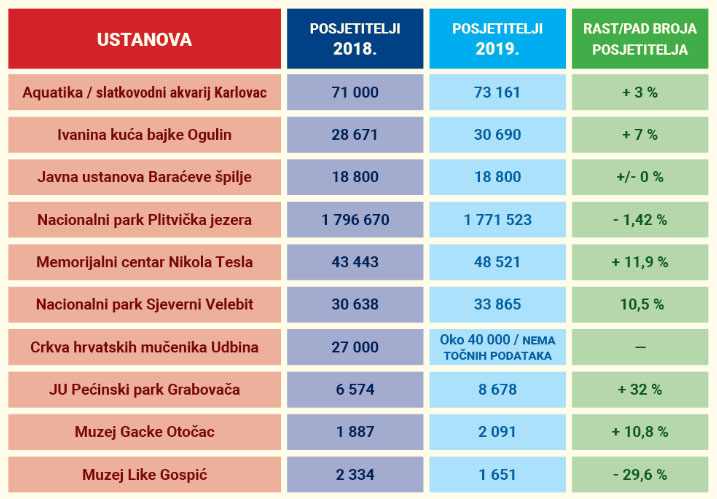Grabovača Cave Becomes the First Cave for Speleotherapy in Croatia
October 15, 2021 - Respiratory therapies within caves, called speleotherapy, have thousands of years of practice dating back to the times of the ancient Greeks and Romans. Now, for the first time, the first cave for speleotherapy in Croatia has been opened in Grabovača Cave Park.
Although Croatia is rich in caves, which are in large numbers in the tourist offer, there was no speleotherapy until last week, reports Turističke Priče. Namely, for the first time in Croatia, in the Grabovača Cave Park, a cave for speleotherapy is being opened. Last week, on the premises of the Institution, the Agreement on granting a concession approval for Medina Cave was signed. The concession approval was granted to the trade "SIGA" from Perušić.
Speleotherapy is a type of respiratory therapy that involves breathing inside a cave. The benefits of this type of therapy were known as far back as ancient Greece and Rome, and modern use began in Germany.
The history of modern speleotherapy dates back to the fifties of the last century. At that time, speleotherapy hospitals were established in several countries of Eastern and Central Europe. In its classical form, speleotherapy was the use of underground minerals and hot springs.
The goal, as they say from the Grabovača Cave Park, is to encourage as long a stay in nature and caves as possible, ie to combine speleotherapy with educational content in the Park area, and to contribute to better promotion of the area. The official opening will be soon, and the interested public will be informed about everything.
By the way, the Grabovača Cave Park is the only cave park in Europe and is located in the area of the Perušić Municipality in Lika. Water enriched with dissolved carbon dioxide with its mechanical and chemical power destroyed and dissolved carbonate rocks on the surface of the relief and in the depths of the Grabovača underground. Thus, countless ravines, oysters, sinkholes were formed on the surface and many pits and caves in the underground.
On a relatively small area of only 1.5 square kilometers, there are eight caves and one pit, which is a set of diverse and rich in calcite formations valuable speleological phenomena, and a quarter of the total number of protected speleological objects in Croatia - five caves are protected in the category of geomorphological monuments nature, and the cave Samograd is the most famous speleological object of this cave park and the only cave that is open to visitors.
For more on travel in Croatia, follow TCN's dedicated page.
Grabovača Cave from Lika Offers Visitors Unusual Souvenir
At first it seemed like an April Fools' joke, but then it turned out there's nothing funny about it: Grabovača cave, located near Perušić in Lika region of Croatia, has started selling little bottles filled with the air collected at the bottom of the cave, and they sold the entire first series of the souvenir!
Tanja Šimundić Bendić wrote about that for Slobodna Dalmacija, how she has received the news about the new souvenir from the Grabovača Cave Park and decided that she needed to investigate if it was a joke or not. But to do that, she decided to take a bottle of ripe Split air, and made her way to Lika, to see the cave and the tourist story that is being created in one of the poorest counties in Croatia.
The bottles are filled with air from the bottom of the Samograd cave in the Grabovača cave system, and it's perfectly clean air: no allergens, no smog, just pure cave air. Tomislav Špehar, one of the park attendants explains that they don't want to bottle too much air, as it needs to stay deep in the cave. So the journalists and the people in the park exchanged gifts, the bottle of air from Split (with added pine needles from Marjan!) and the bottle of perfectly clean Lika air. After some consideration of the dangers of potential infestation with bark beetle (which has wreaked havoc on Marjan in recent years), they've decided that there is no real danger in letting some of the Split craziness into their cave. And out of the blue, came an idea: let's have a museum of air in Grabovača! So, if you decide to visit Grabovača, bring a little bottle of air from back home, to be exhibited at the Park!
The original idea for the bottled air as a souvenir of Grabovača came last year when they had over 6,5 thousand visitors. So last autumn they put the bottles inside the cave, where they sat all winter, getting filled with cave air, and in March they were closed and the original souvenir was offered to the tourists. And that souvenir took off, much better than expected. People are asking for the cave air (just like the journalist did), and it's a remarkable marketing tool. Once the visitors come, in addition to some bottled air, they also get to see the caves, the nature around them, they get to learn from the crew working at Grabovača Cave Park about the nature, caves, behaviour in caves, nature conservation etc.
And if there's one thing you can be sure of, it's that the nature in Lika is spectacular. Lush green all around, with wonderful footpaths with lots of information ready for tourists, eco playgrounds, vistas, picnic zones... There are nine caves in the park, which has around 600 hectares of surface area, and ambitious plans to expand to over 6000 hectares and to almost 40 speleological objects. The temperature in the Samograd cave does not change much, it is constantly between 7 and 10 Celsius.



